Rakshasa Riddles
In response to my post earlier today about the appearance of mimics, a reader correctly commented that the rakshasa faces a similar problem. Though originally introduced in The Strategic Review (and then appearing in Gods, Demigods & Heroes), the first time we see an illustration of the monster, it's in the AD&D Monster Manual (1977) by Dave Trampier:
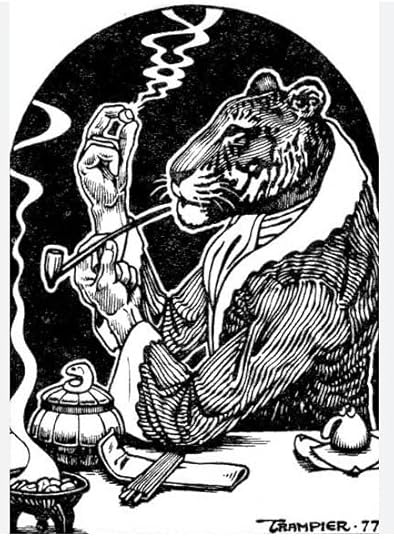
This is a great illustration, one of my favorites in the MM. I also like the inclusion of a bolotomus in the bottom righthand corner of the piece – a great example of the kind of whimsy that categorized a lot of old school fantasy. But how accurately does it depict what Gary Gygax describes in the text? The Monster Manual states, "Known first in India, these evil spirits encased in flesh are spreading." The text also notes that they are "masters of illusion" who use their powers of ESP to "create the illusion of what those who have encountered them deem most friendly." This last detail seems to me to be confirmation of the monster's having been inspired by the Kolchak: The Night Stalker episode, "Horror in the Heights," a fact Gygax himself readily admitted.
Of course, the question immediately arises: why, then, did Tramp choose to illustrate the rakshasa in this way? The Monster Manual says nothing about the native appearance of the creature, so why is it depicted as a tiger-headed humanoid in a smoking jacket and ascot? Is it because Gygax noted that rakshasas were "known first in India" and there's a strong pop cultural connection between India and tigers in the English-speaking world? On the other hand, the native form of Kolchak's rakshasa was a big furry thing reminiscent of Bigfoot, so what gives?
To confuse the question further, consider these miniature figures, released by Grenadier in 1980, that supposedly feature two rakshasas:
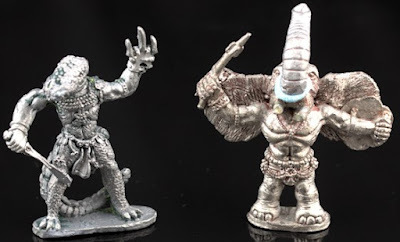 I used to own these miniatures and I remember being quite perplexed by their appearance, since one looks like a lizard man and the other an elephant man. After some thinking about the matter, my youthful self used these minis as license to stat up several different types of rakshasas, on the model of the various types of demons and devils. I wish I still had those stats, because I imagine they'd make for fun reading today.
I used to own these miniatures and I remember being quite perplexed by their appearance, since one looks like a lizard man and the other an elephant man. After some thinking about the matter, my youthful self used these minis as license to stat up several different types of rakshasas, on the model of the various types of demons and devils. I wish I still had those stats, because I imagine they'd make for fun reading today.Issue #84 of Dragon (April 1984) features an article by Scott Bennie entitled "Never the Same Thing Twice," which takes a similar tack, introducing several different kinds of rakshasas. According to Bennie, "rakshasas have no uniform physical appearance," stating only that "legend usually describes them as deformed and monstrous-looking." The types of rakshasa he introduces differ only in power, not in appearance. Nevertheless, the article is accompanied by the following illustration by Jim Holloway:
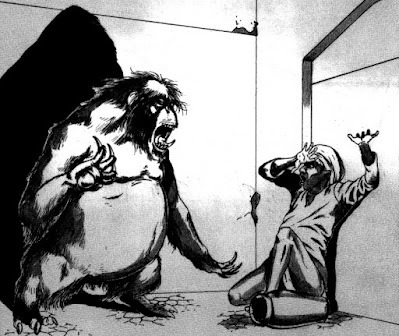 Beneath the illustration, there's some explanatory text that says it's based on a description from the Funk and Wagnalls Standard Dictionary of Folklore, Mythology, and Legend. The dictionary in question describes the rakshasa as having "a big belly, fingers that curve away from the palms of its hands, and claws that are said to be poisonous." The text further states that the rakshasa is not using its illusion powers, "preferring to let the poor victim see what he's really up against," which suggests this is the monster's true form. To me, he looks a little bit like the Kolchak version, in that it's big, furry, and apelike, but ir's otherwise unique in the history of depicting the rakshasa.
Beneath the illustration, there's some explanatory text that says it's based on a description from the Funk and Wagnalls Standard Dictionary of Folklore, Mythology, and Legend. The dictionary in question describes the rakshasa as having "a big belly, fingers that curve away from the palms of its hands, and claws that are said to be poisonous." The text further states that the rakshasa is not using its illusion powers, "preferring to let the poor victim see what he's really up against," which suggests this is the monster's true form. To me, he looks a little bit like the Kolchak version, in that it's big, furry, and apelike, but ir's otherwise unique in the history of depicting the rakshasa.The volume 1 of the 2e AD&D Monstrous Compendium describes rakshasas as having "no uniform appearance but appear as humanoid creatures with the bodily features of various beasts (most commonly tigers and apes)." It also notes that "hands whose palms curve backward, away from the body, seem to be common" and that "rakshasas of the highest standing sometimes have several heads." However, the accompanying illustration (by Jim Holloway), looks like this:
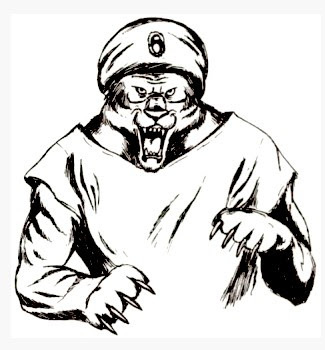 It's a rather laughably generic tiger-man in "Indian" clothing. I presume it takes its inspiration from the Trampier original, but it lacks all the style. More significantly, the Holloway rakshasa is a humanoid tiger, while Tramp's is (seemingly) a man with a tiger's head – look at his hands, for example.
It's a rather laughably generic tiger-man in "Indian" clothing. I presume it takes its inspiration from the Trampier original, but it lacks all the style. More significantly, the Holloway rakshasa is a humanoid tiger, while Tramp's is (seemingly) a man with a tiger's head – look at his hands, for example.The 1993 Monstrous Compendium includes a new rakshasa illustration, this time by Tony DiTerlizzi.
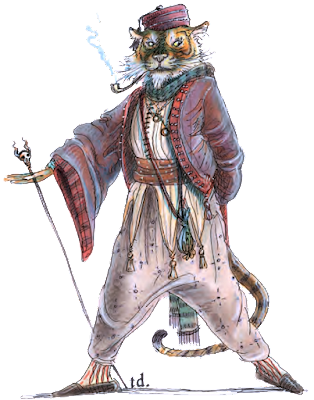
This one seems to occupy a mid-point between Trampier and Holloway, in that it's not quite a humanoid tiger (though it does have a tail), but it's also not simply a man with a tiger's head. Notice the backward hand, holding its skull-topped walking stick. DiTerlizzi's rakshasa undoubtedly has style, but the question remains: why is he depicted as a tiger? Is it simply, as my reader suggests, that the earliest art showing a rakshasa portrayed him in this way and all subsequent artists have been following Tramp's lead? If so, it's very disappointing, especially when dealing with a monster whose primary power is the ability to shapechange.
Illustrations, especially of fantastical things, can be very useful aids to one's imagination. However, they can also inadvertently limit one's imagination. The more I look at the history of D&D's artwork, the more evidence I see of the latter.
James Maliszewski's Blog
- James Maliszewski's profile
- 3 followers



